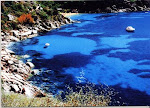TV-Tipp - Können in Gefangenschaft gehaltene Delfine wieder ausgewildert werden?
Delfine leben und lernen in sozialen Verbänden. Ohne den Schutz der Gruppe sind sie verloren. Genau das passiert im israelischen Eilat - drei Tiere werden von der Gruppe abgelehnt. Riskanter Plan der Tiertrainer: Das in Gefangenschaft geborene Trio soll künftig im Schwarzen Meer leben.
Mittwoch, 23.04. - Tierreport - 19.00 Uhr - ARTE
_______________________________________
Um diese riskanten Auswilderungsaktionen zu vermeiden, muss es verhindert werden, dass Delfine überhaupt in Gefangenschaft "leben". Deshalb fordern wir ein:
Ausnahmsloses Importverbot für Wale & Delfine nach Deutschland!
Bereits über 1000 Einträge in der Solidaritätsliste - 170 Tierschutzvereine und Organisationen unterstützen diese Forderung!
Machen Sie mit!
Falls noch nicht geschehen, bitte ich um einen Eintrag in die SOLIDARITÄTSLISTE! Alle Einträge werden bei einer Aktion am 9. Mai in Berlin der Bundesregierung übergeben und auf dem größten Delfin-Schutz-Transparent Deutschlands (1 Kilometer) integriert und den Politikern und auch allen Medien in Deutschland präsentiert.
Wir fordern die Bundesregierung auf, endlich ein Gesetz für ein Importverbot für Wale & Delfine nach Deutschland zu beschließen, damit die Delfinarien in Deutschland keine weiteren Tiere mehr aus anderen Anlagen oder aus der freien Wildbahn erhalten können. Weil die Nachzucht nicht funktioniert, werden die Delfinarien mittelfristig alle schließen müssen.
Helfen Sie bitte mit, die Ausplünderung der Meere zu stoppen – setzen wir ein starkes solidarisches Zeichen, um noch mehr Tierleid zu verhindern!
Eintragungsmöglichkeit bis 30.04.08
Info & Online-Formular unter:
http://walschutzaktionen.de/334601.html
Unterschriften-Listen zum Ausdrucken:
http://walschutzaktionen.de/392601.html
Bitte leiten Sie diesen Aufruf zum Schutz der Delfine auch an Ihre Freunde und Bekannte weiter!
Vielen Dank!
-----------------------------
Andreas Morlok
Delfin- & Walschutz-Aktivist
Internet: http://www.walschutzaktionen.de
E-Mail: walfahrt@t-online.de


